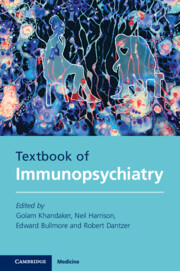Book contents
- Immunopsychiatry
- Immunopsychiatry
- Copyright page
- Contents
- Foreword
- Contributors
- Chapter 1 Basic Concepts in Immunobiology
- Chapter 2 From Psychoneuroimmunology to Immunopsychiatry: An Historical Perspective
- Chapter 3 Stress, Immune System and the Brain
- Chapter 4 The Role of Prenatal and Childhood Infection and Inflammation in Schizophrenia
- Chapter 5 The Role of Autoimmune Encephalitis in Immunopsychiatry and Lessons from Neuropsychiatric Systemic Lupus Erythematosus
- Chapter 6 Effectiveness of Immunotherapies for Psychotic Disorders
- Chapter 7 Inflammation, Sickness Behaviour and Depression
- Chapter 8 Immunotherapies for Depression
- Chapter 9 The Effect of Systemic Inflammation on Cognitive Function and Neurodegenerative Disease
- Chapter 10 Role of Inflammation in Lewy Body Dementia
- Chapter 11 The Role of Adaptive and Innate Immunity in Alzheimer’s Disease
- Chapter 12 The Immune System and Anxiety Disorders
- Chapter 13 Microbiome-Gut-Brain Interactions in Neurodevelopmental Disorders: Focus on Autism and Schizophrenia
- Chapter 14 Depression and the Adaptive Immune System
- Chapter 15 Transdiagnostic Features of the Immune System in Major Depressive Disorder, Bipolar Disorder and Schizophrenia
- Index
- Plate Section (PDF Only)
- References
Chapter 2 - From Psychoneuroimmunology to Immunopsychiatry: An Historical Perspective
Published online by Cambridge University Press: 02 September 2021
- Immunopsychiatry
- Immunopsychiatry
- Copyright page
- Contents
- Foreword
- Contributors
- Chapter 1 Basic Concepts in Immunobiology
- Chapter 2 From Psychoneuroimmunology to Immunopsychiatry: An Historical Perspective
- Chapter 3 Stress, Immune System and the Brain
- Chapter 4 The Role of Prenatal and Childhood Infection and Inflammation in Schizophrenia
- Chapter 5 The Role of Autoimmune Encephalitis in Immunopsychiatry and Lessons from Neuropsychiatric Systemic Lupus Erythematosus
- Chapter 6 Effectiveness of Immunotherapies for Psychotic Disorders
- Chapter 7 Inflammation, Sickness Behaviour and Depression
- Chapter 8 Immunotherapies for Depression
- Chapter 9 The Effect of Systemic Inflammation on Cognitive Function and Neurodegenerative Disease
- Chapter 10 Role of Inflammation in Lewy Body Dementia
- Chapter 11 The Role of Adaptive and Innate Immunity in Alzheimer’s Disease
- Chapter 12 The Immune System and Anxiety Disorders
- Chapter 13 Microbiome-Gut-Brain Interactions in Neurodevelopmental Disorders: Focus on Autism and Schizophrenia
- Chapter 14 Depression and the Adaptive Immune System
- Chapter 15 Transdiagnostic Features of the Immune System in Major Depressive Disorder, Bipolar Disorder and Schizophrenia
- Index
- Plate Section (PDF Only)
- References
Summary
- It was the best of times, it was the worst of times,
- it was the age of wisdom, it was the age of foolishness,
- it was the epoch of belief, it was the epoch of incredulity,
- it was the season of Light, it was the season of Darkness,
- it was the spring of hope, it was the winter of despair …
- Type
- Chapter
- Information
- Textbook of Immunopsychiatry , pp. 25 - 50Publisher: Cambridge University PressPrint publication year: 2021
References
- 2
- Cited by

